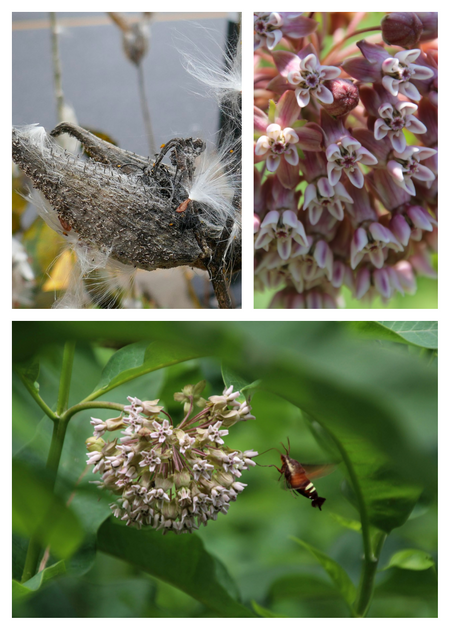Common Milkweed

Scientific Name: Asclepias syriaca L.
Common Name: Common milkweed, butterfly flower, silkweed, silky swallow-wort, and Virginia silkweed
Plant Family: Apocynaceae (Milkweed family)
Etymology: Asclepias refers to Asklepios, the Greek god of medicine, given the plant’s long history of medicinal use. The specific epithet, syriaca, means “of Syria” based on the mistaken belief this North American native was from Syria.
Parts Used: whole plant
Season: spring, summer, fall
Indigenous Uses
Asclepias syriaca was used widely for a variety of purposes. As a food, people ate the boiled young sprouts like asparagus, cooked the unopened floral bud clusters and firm green fruits, as well as the tender leaves and upper stalks. The flowers and buds often thickened soups. Dried buds were stored for winter use. The latex was boiled and mixed with animal fat for a chewing gum. As a craft product, the fibers were used as cordage for bowstrings and fine sewing threads. Fibers from inside the large pods were used as a stuffing for pillows and sleeping pads. The milky juice was used as a glue. As a medicine, the plant supported treatment of venereal diseases, kidney and urinary dysfunction, rheumatism, and backaches. It was also used as a laxative, galactagogue, and contraceptive. Topically it was used to remove warts and treat bee stings, cuts, and ringworm.
Edible Parts
Gather the tender young shoots by snapping off an inch above the ground. Boil for 20 minutes before serving with butter or adding to frittatas. Pinch off the whole green flower heads and boil, stir-fry, steam, or cook into soups. Remove the young firm pods when under 1½ inches long and cook like okra. Pull out the seed fibers when the pods are beginning to lose firmness but are still green. Boil, strain, and add to dishes for a cheese-like texture and mild flavor. Preserve the shoots, flowerheads, and young pods by blanching and freezing.
Caution: Some people have a food sensitivity to milkweed. Try a small amount to ensure it agrees with you.

This project was made possible by a grant from Maryland Humanities, with funding received from the Maryland Historical Trust in the Maryland Department of Planning. Maryland Humanities’ Grants Program is also supported by the National Endowment for the Humanities and private funders. Any views, findings, conclusions, or recommendations expressed on this website do not necessarily represent those of Maryland Humanities, Maryland Historical Trust, Maryland Department of Planning, or National Endowment for the Humanities.

